Penalty
Penalty was invented by Ernesto Scola of Milan and published in the UK by Pepys in the 1960s
Penalty was invented by Ernesto Scola of Milan working with a team of twelve specialists who took five years including playing 18,000 trial games to develop the game. It was first published on the continent and in South America before being published and distributed in the UK by Pepys in the 1960s. The game describes itself as “A game of skill for 2 to 6 players”, but in reality is a two-person game, one of the classic father-son games from a bygone era we used to play on dark winter evenings after dinner was cleared away. See the Rules►
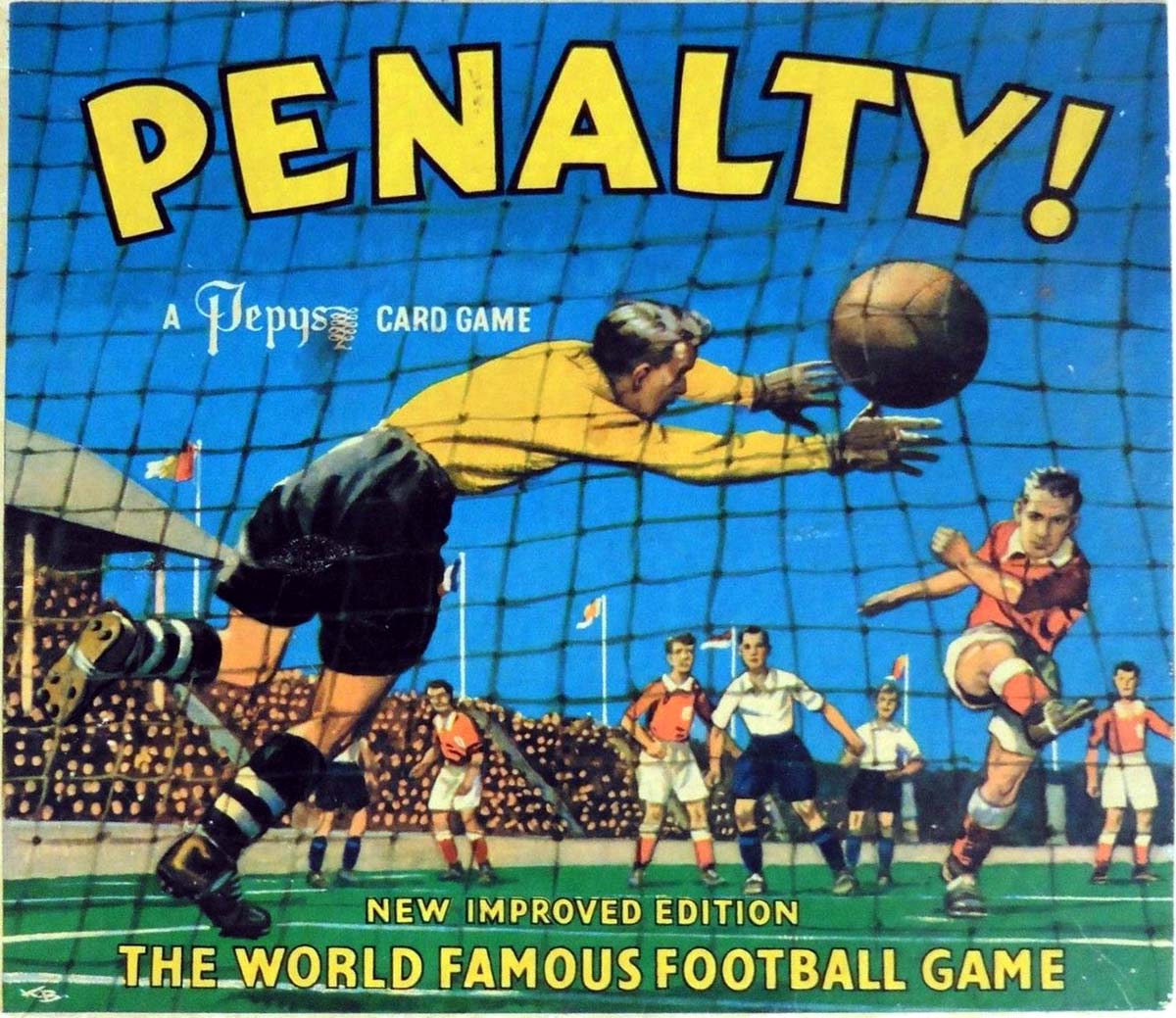
Above: box from the 3rd edition which included a wooden ‘ball’. Subtle differences to the artwork can be seen between the first editions.
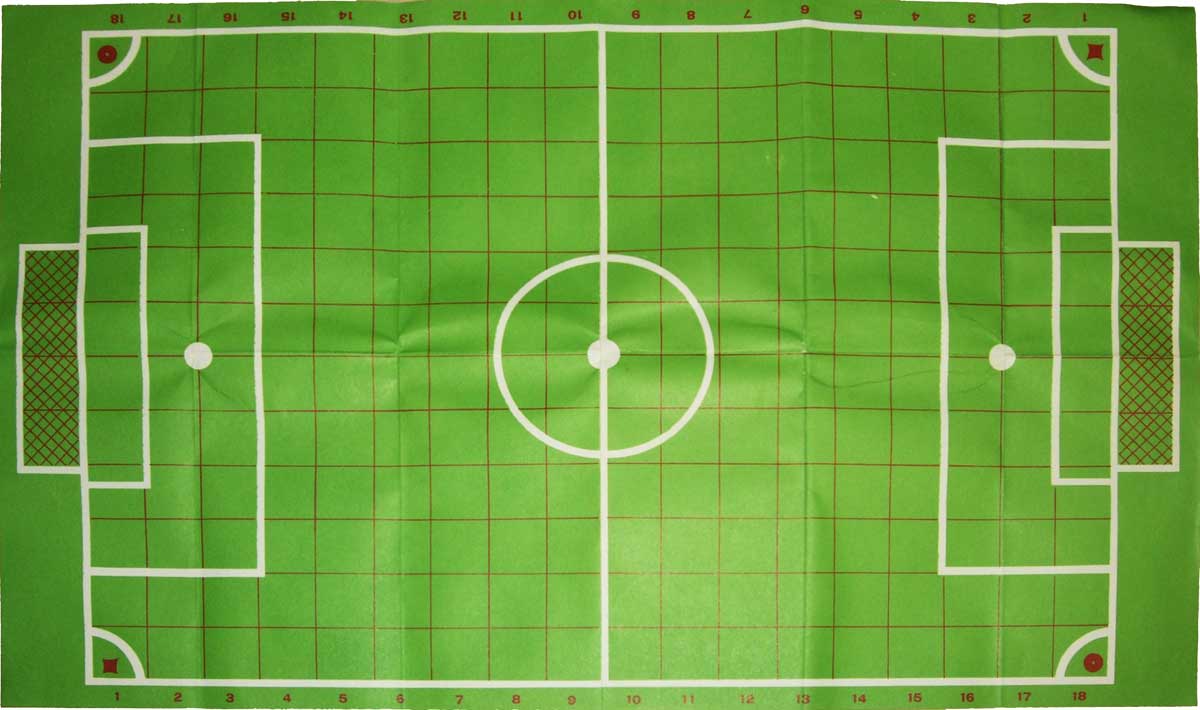
Above: the game simulates a game of football. As such it is a game of two halves and the object is to score more goals than your opponent. Play follows the standard football rules but moves are made by the playing of cards which dictate the position of a ‘ball’ on a paper pitch.
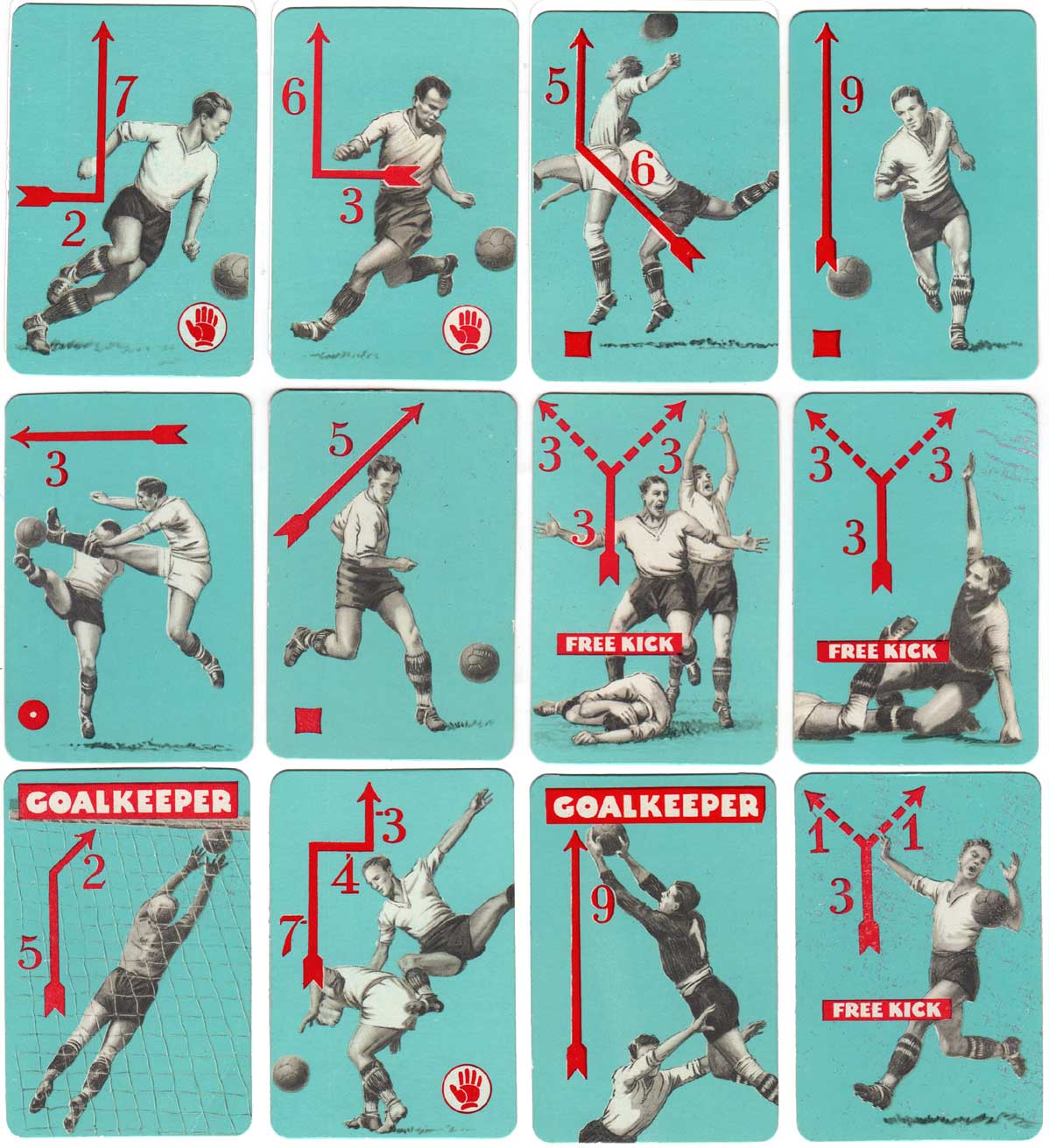
Above: there are 52 cards in the pack, every card has a different image of a player or players in an animated pose, and this pack of cards is made up of five different types of card: movement or kick cards of which there are 38; free kick cards of which there are 4; corner cards of which there are also 4; goalkeeper cards of which there are 5 and one penalty card.
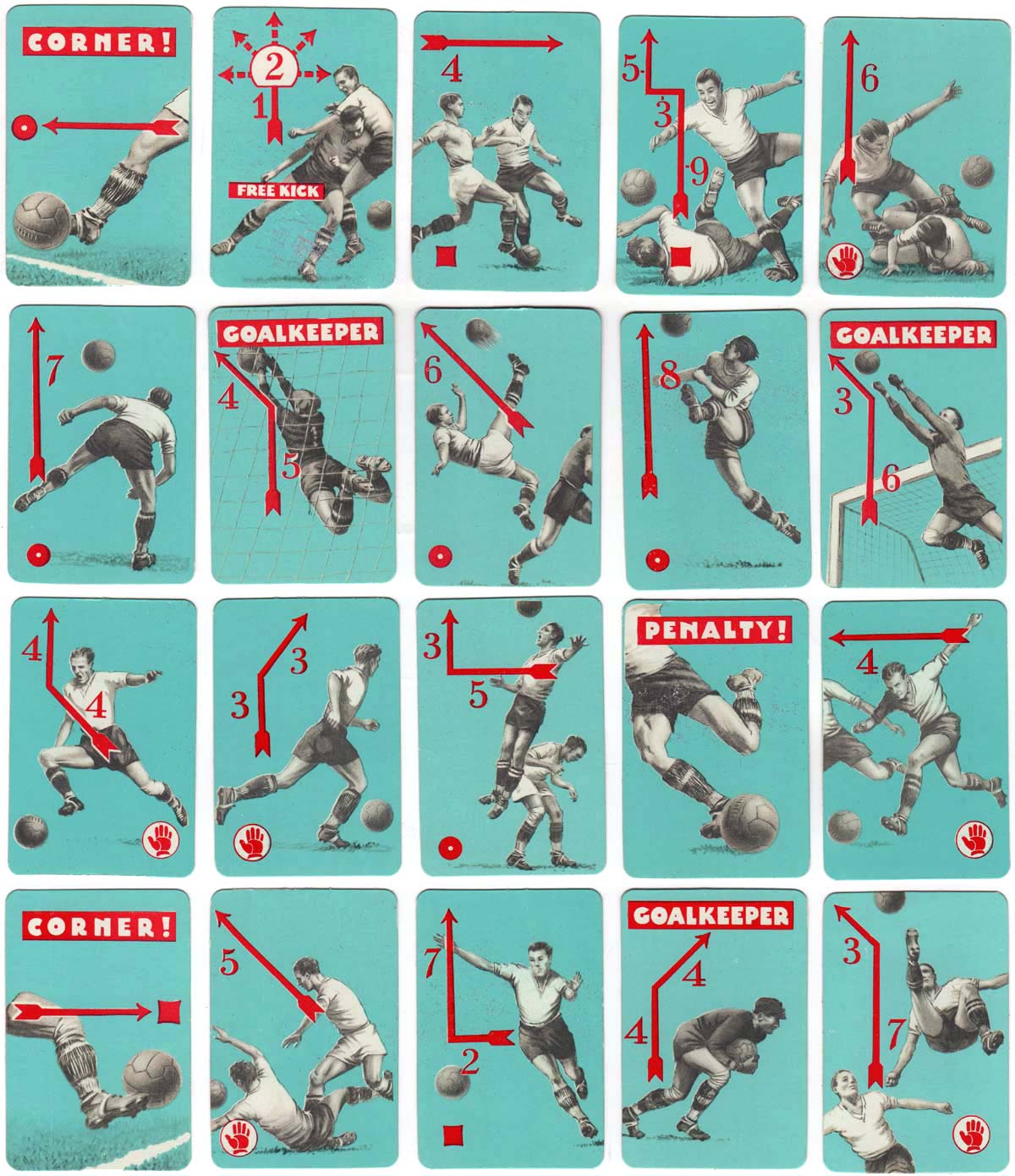
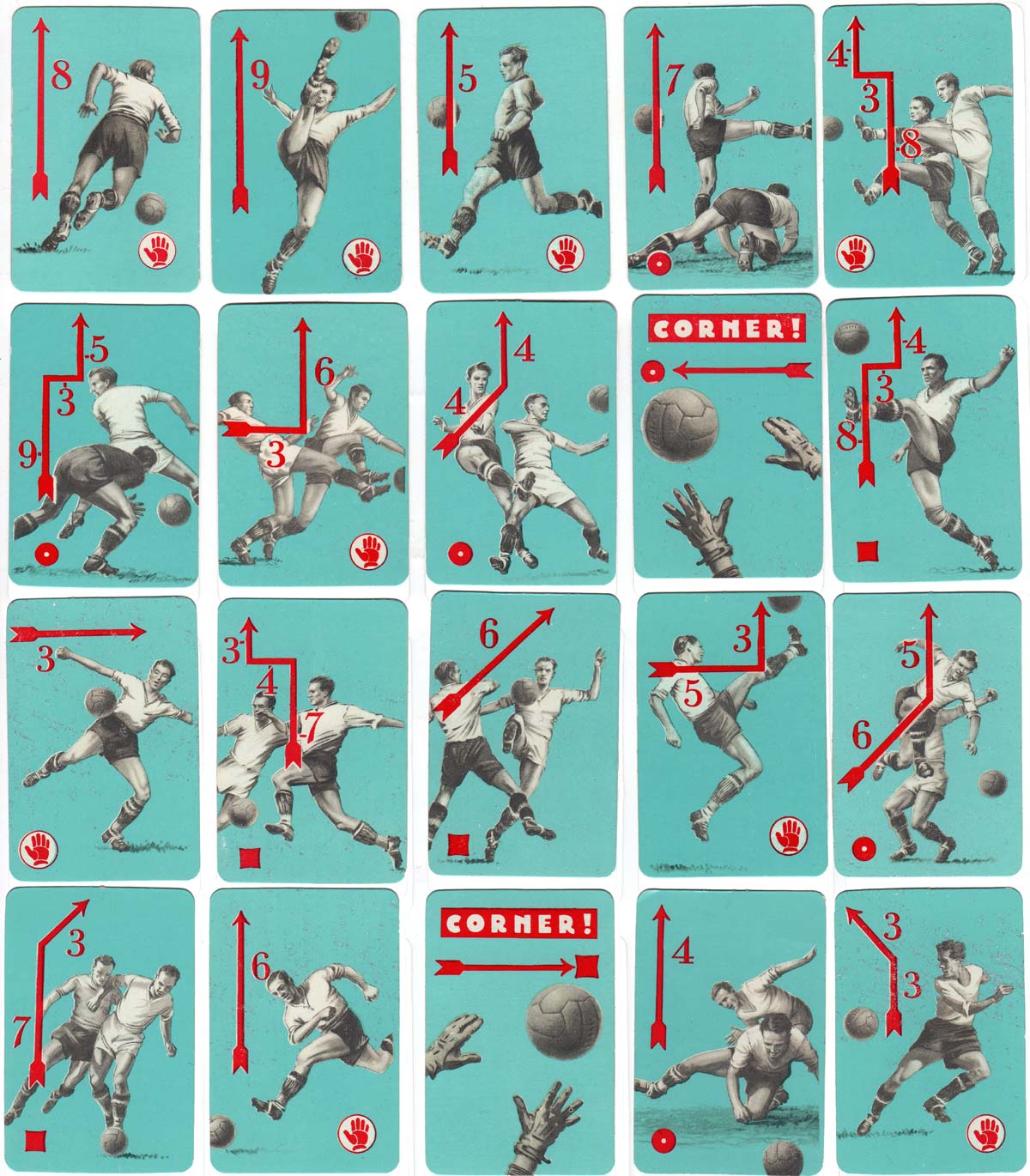
Above: Penalty table-top card game published by Pepys Games in c.1960. In 2010 the game was re-released under the title "Goal" by Lagoon group, with allegedly the same art work etc as the earlier versions.
-
Synopsis of the Rules
The rules are not simple, but neither are they overly complicated. This is a simplified synopsis of the rules.
The pack is shuffled, each player receives a small number of cards, and the remained of the pack is placed face down. The ball is placed on the centre spot and a kick-off commences the game with one player choosing one of the movement cards from his hand, playing it by laying it face up next to the undealt remainder of the pack, and moving the ball the places designated on the card. He then draws the top card from the undealt pack and places it in his hand to replace the played card. The other player then plays in a similar fashion and moves the ball accordingly.
The games gets a bit more complicated, goal kicks are taken if the ball crosses the goal line to the left or right of the goal. If the ball enters the goal a shot at goal is declared, which may be saved or not by the defending player. If the defending player can play either a goal keeper or corner card the goal is saved and a corner may or may not be awarded appropriately. If a goal is scored, the ball returns to the centre spot for kick-off by the defending team as in a real game of football.
At any time during the game when a player has played a card which takes the ball into the opposing team's penalty area he may immediately play the penalty card also, if he has it. A penalty then takes place, with the ball being placed on the penalty spot. The penalty is decided by the defending team cutting the undealt pack, if the card cut has a hand symbol on it, the penalty is saved, otherwise the penalty is scored.
A free-kick card may be played at any time the ball is not within the opposing team's penalty area, and is followed by being played by an ordinary movement card or the penalty card if possible and desired, unless the free kick causes a shot at goal. A player might play three cards: free-kick, moves the ball, movement card, moves the ball, and then if the ball is in the opposing team's penalty area he may play the penalty card!
Throw-ins take place if the ball crosses the side lines. The next player conducts a throw-in by moving the ball 2 squares in any direction from the square where it left the pitch, counting that square as one of the two, and immediately afterwards the player plays a normal card as usual.
The first half ends when the last card of the undealt pack is picked up. A player may not play more cards than remain in the undealt pack. The second half commences with a shuffle of the discarded cards, which are then placed face down to form the undealt pack, and play continues as one might expect, commencing with a centre.

By Matt Probert
Member since March 02, 2012
I have adored playing cards since before I was seven years old, and was brought up on packs of Waddington's No 1. As a child I was fascinated by the pictures of the court cards.
Over the next fifty years I was seduced by the artwork in Piatnik's packs and became a collector of playing cards.
Seeking more information about various unidentified packs I discovered the World of Playing Cards website and became an enthusiastic contributor researching and documenting different packs of cards.
I describe my self as a playing card archaeologist, using detective work to identify and date obscure packs of cards discovered in old houses, flea markets and car boot sales.
Related Articles

OXO Faces of the Millennium Dinner
Twentieth-century personalities promoting a millennium dinner at the Oxo Tower in London.

Kids Fun Box playing cards
Colourful cards for children with four non-standard suits connected with the natural world.

Tangle Foot Ale
Badger Brewery Tangle Foot strong ale advertising pack.

ViVa Bourg
A distinctive deck of cards for a specific promotion.

Sumo Wrestling
Traditional Japanese Sumo Wrestling playing cards with photograph of different wrestler on each card...

Dancing
“Dancing” playing cards manufactured by Nintendo for Torii Dance School, Osaka.

Scientific Whist
“Scientific Whist” : standard cards with instructions for play on the faces by Chas Goodall & Son, 1...

Agent Provocateur
Branded lingerie collection in a pack of pin-up playing cards.

Nimbus playing cards
Mike Steer’s weather-themed pack with suits in four colours and backs for cardistry.

Agatha Christie and Playing Cards revisited
Agatha Christie uses card-play as a primary focus of a story, and as a way of creating plots and mot...

The Decadent Deck
Studies in the eroticism of the female body by Inge Clayton.

Historic Shakespeare
“Historic Shakespeare” playing cards featuring Shakespearean characters by Chas Goodall & Son.

Copechat Paramount Sorting System
Preserving the past: a specimen deck showcasing edge-notched cards and their ingenious sorting syste...

Heartsette by Herbert Fitch & Co, 1893
A glimpse into a busy print and design office in late Victorian London.

Rap Rummy
Rap Rummy made by Parker Brothers in 1926, only 4 years after the discovery of King Tutankhamen’s to...

Batman® playing cards
Batman playing cards published by InterCol of London 1989.
Most Popular
Our top articles from the past 28 days

